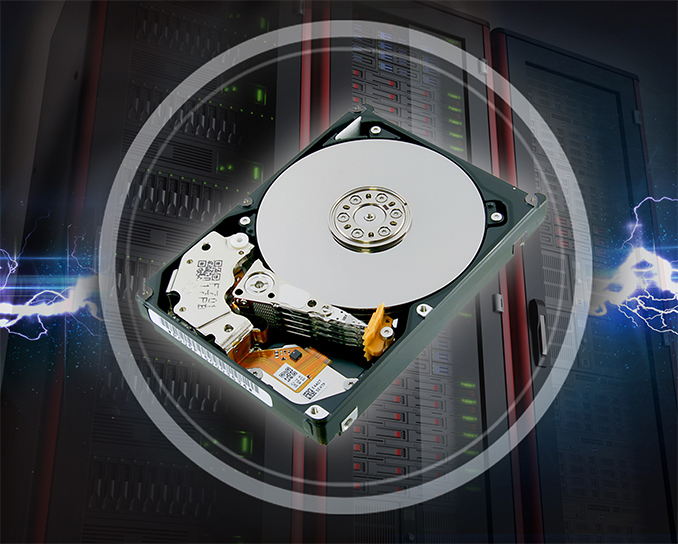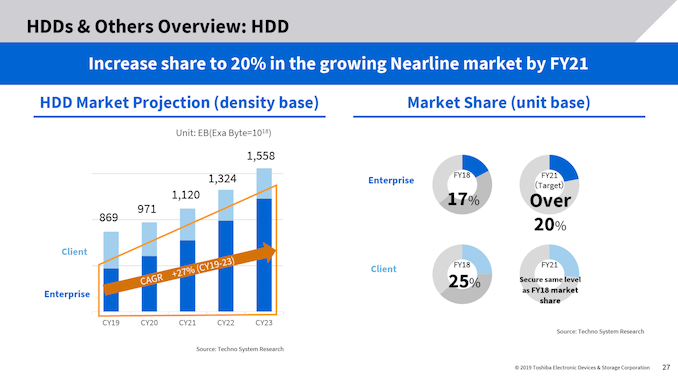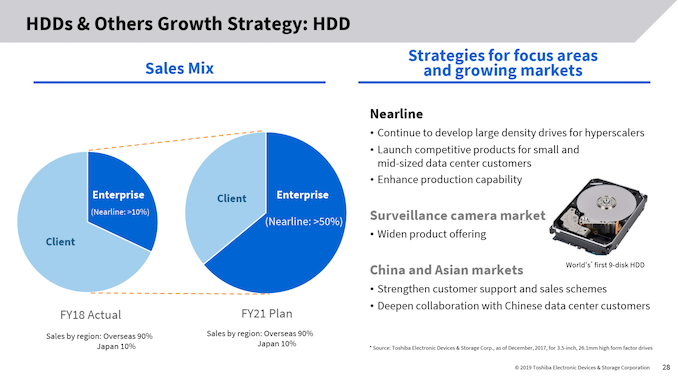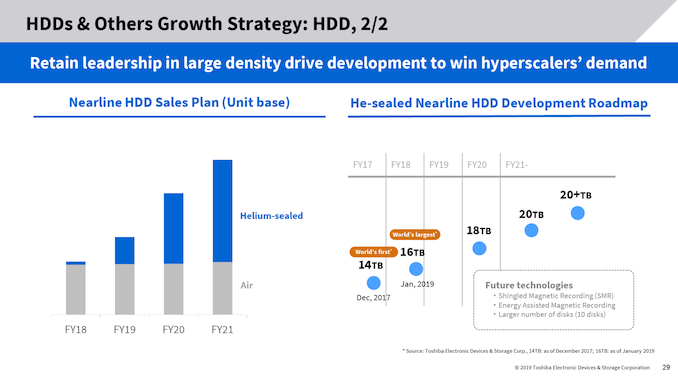Toshiba to Expand HDD Production: 20 TB & 10-Platter Drives Coming
by Anton Shilov on December 2, 2019 2:00 PM EST- Posted in
- Storage
- Toshiba
- HDDs
- Helium HDD

While hard drive sales on a unit basis have continued to decline, the drop hasn't been consistent across all segments of the market. In particular, high capacity drives for hyperscalers and other hosts continue to be a hot commodity, as their data storage needs continue to grow and there are few other alternatives. As such, Toshiba has announced that the company will actually be increasing its HDD production capacity, expanding one of its plants in Philippines to increase output of high-end helium-filled enterprise and nearline HDDs. The company is confident of its roadmap (and growing demand for its products) which includes numerous promising products and technologies.
The overall broad shift in HDD demand from lower capacity client to high capacity nearline drives comes as Toshiba finds itself on the outside looking in. The company’s sales mix is dominated by client HDDs, with enterprise drives accounting for about a third of it. So while Toshiba controls about 36% of the global mobile HDD shipments, it only has around 17% of the enterprise/nearline market. As a result, Toshiba is looking to make changes to capture more of the nearline market.
At its Investors Day last month, Toshiba outlined plans to radically increase the share of enterprise/nearline HDDs in its product mix in FY2021 (starts on April 1, 2021), shifting away from client drives and towards nearline drives. Overall, the company set itself a goal to capture an ‘over 20%’ share of the global enterprise/nearline HDD market while maintaining its share of the client HDD market at around 25%
To reach its new goals, Toshiba not only needs to ramp up production, but it will need to ensure it has competitive pricing and technology as well. This means the company needs to continue to invest in developing leading-edge high-capacity nearline drives for hyperscale datacenters, while at the same time keeping prices in check so that they are priced competitively for the small and mid-sized datacenter market. As well, Toshiba will have to focus on client issues, such as improving its customer support as well as collaborating more with Chinese datacenter clients.
On the product side of things, Toshiba has a rather solid roadmap. Earlier this year the company confirmed that it would use shingled magnetic recording (SMR) and energy assisted magnetic recording (EAMR) technologies (e.g., MAMR, HAMR) to boost areal density. In addition to that, the company’s roadmap now officially includes drives with 10 platters (up from nine today). Which to offer some context, a 10-platter design using the highest-capacity platters available today would enable a 22 TB HDD. Though it bears mentioning that adding a 10th platter to existing drives is not a trivial task (i.e. how do you fit it in?), so Toshiba isn't disclosing when they expect to have their 10-platter design ready.
In the meantime, the company’s roadmap includes a 20 TB HDD as soon as FY2021. And, going forward, all of Toshiba's leading-edge hard drives will be helium-filled.
The big challenge – as is often the case – is on the manufacturing side of matters. Toshiba’s current capacity to build helium-filled devices in its Carmelray Industrial Park plant is somewhat limited, so the company needs to expand these production lines to meet demands it is going to face in the coming years. It's fitting then that even Toshiba is being a bit cautious here, holding off on disclosing specific production goals for helium drives.
Related Reading:
- Toshiba's HDD Tech Roadmap: A Mix of SMR, MAMR, TDMR, and HAMR
- 18 TB HDDs: Toshiba Collaborates with Showa Denko for MAMR HDDs
- Toshiba at CES 2019: World’s First 16 TB TDMR HDD Debuts
- Toshiba Launches 12 TB and 14 TB HDDs for Desktops and NAS
- Demand for HDD Storage Booming: 240 EB Shipped in Q3 2019
- Shipments of PC Hard Drives Predicted to Drop By Nearly 50% in 2019
- Seagate to Shut Down One of Its Largest HDD Assembly Plants
- Western Digital to Shut Down HDD Manufacturing Facility, Increase Production of SSDs
Source: Toshiba














18 Comments
View All Comments
keg504 - Monday, December 2, 2019 - link
What's with the Times New Roman "C" in the title?jordanclock - Monday, December 2, 2019 - link
I am so glad I'm not the only one thrown off by that.TheSkullCaveIsADarkPlace - Monday, December 2, 2019 - link
That's because there is no actual latin letter C in the title. For whatever reason, there is the kyrillic uppercase letter "Es" (U+0421) in the title, which basically looks like a latin C, but is a different character.It seems the font used for the title (Rokkitt) does not provide a glyph for character U+0421 (the kyrillic uppercase "Es"), making the browser fall back to a serif font (serif is mandated by the title's CSS style) that provides a glyph for U+0421. Which happens to be Times New Roman (not sure what the fallback font would be on Linux, Mac or mobile browsers...)
Ryan Smith - Monday, December 2, 2019 - link
Thanks. I'm not sure how that happened, but it's been fixed.HardwareDufus - Monday, December 2, 2019 - link
I recall just reading a few short months ago that manufactures/customers had no desire to move beyond 16TBs in a single drive as they thought that was just too much data to rebuild should they have a hardware failure. Guess, that concern is nill.. as 20TB represents a 25% increase over 16TB.That's allot of consumer purchasing data to store..... Orwell would be proud.
qap - Monday, December 2, 2019 - link
It depends on ops. Ours have no desire to go beyond around 4TB for HDD. Recovery from single drive failure takes hours or even days.Fundamental problem of HDD is that capacity is increased with number of tracks, density of data on tracks (and number of platters to very limited extent) while speed is increased only with density of data on track and that is only relevant for linear speed. Ie speed is increasing with square root of capacity. HDDs are literally outgrowing their usefulness.
GreenReaper - Tuesday, December 3, 2019 - link
Yeah, even a 4-disk RAID5 makes me nervous with 2-4TB as it takes about 8-24 hours to rebuild. Saw a good 4x12TB offer from OVH recently but I'm not sure I'd go for it if I expected to use all 12TB.DanNeely - Monday, December 2, 2019 - link
I suspect redundancy levels also play a factor. If you can only survive a single drive failure without data loss your need to load the replacement asap is a lot higher than if you're able to survive 2 or more drive failures.Do any of the big cloud providers provide public information on how redundant their data storage setups are?
sheh - Monday, December 2, 2019 - link
https://www.backblaze.com/blog/vault-cloud-storage...rpg1966 - Monday, December 2, 2019 - link
* a lot/pedant